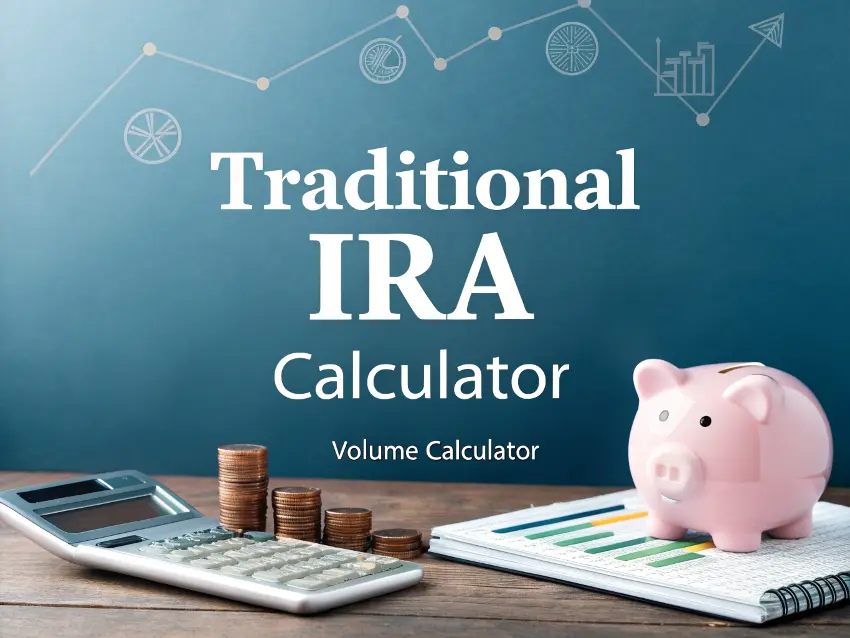Traditional IRA Calculator
Calculate your Traditional IRA growth and tax advantages

Traditional IRA
How Traditional IRAs Work:
A Traditional IRA (Individual Retirement Account) is a tax-advantaged retirement savings account that allows your investments to grow tax-deferred.
Tax Advantages: Contributions to Traditional IRAs may be tax-deductible, reducing your current taxable income. Your investments grow tax-deferred until withdrawal in retirement.
Required Minimum Distributions (RMDs): You must start taking withdrawals by age 73 (as of 2023).
Annual Contribution Limits (2023): $6,500 for individuals under 50, and an additional $1,000 "catch-up" contribution for those 50 and older.
Traditional vs. Roth IRA:
| Feature | Traditional IRA | Roth IRA |
|---|---|---|
| Contributions | Pre-tax (may be deductible) | After-tax (not deductible) |
| Growth | Tax-deferred | Tax-free |
| Withdrawals | Taxed as income | Tax-free (if qualified) |
| RMDs | Required at age 73 | Not required |
| Best for | Those who expect lower tax rate in retirement | Those who expect higher tax rate in retirement |
IRA Benefits
- Tax Advantages: Potential tax deduction now, tax-deferred growth
- Investment Flexibility: Wide range of investment options
- Compound Growth: Tax-deferred growth accelerates wealth accumulation
- Protection: Bankruptcy and creditor protection in many states
Calculate Your IRA Growth
Current Information
$
$
Max: $6,500.00 (no catch-up contribution)
Investment & Tax Settings
%
Typical range: 5-9% (historical average)
%
Historical average: 2-3%
%
Your current marginal tax rate
%
Expected tax rate during retirement
IRA Growth Projection
Balance at Retirement:
$0.00
In 0 years at age 65
Inflation-Adjusted Balance:
$0.00
In today's purchasing power
Total Contributions:
$0.00
Total Interest Earned:
$0.00
Income Tax Savings:
$0.00
From tax-deductible contributions
After-Tax Value:
$0.00
After paying taxes in retirement
Projected Monthly Income:
$0.00
Using the 4% withdrawal rule
IRA Balance Growth Over Time
Traditional IRA FAQs
What is a Traditional IRA?
A Traditional IRA is a tax-advantaged retirement account that allows your investments to grow tax-deferred until withdrawal in retirement. Contributions may be tax-deductible depending on your income and whether you or your spouse have access to employer-sponsored retirement plans.
Who can contribute to a Traditional IRA?
Anyone with earned income can contribute to a Traditional IRA, but the tax deductibility of contributions may be limited if you or your spouse participate in an employer-sponsored retirement plan and your income exceeds certain limits. You can contribute to a Traditional IRA regardless of your income level.
How much can I contribute to a Traditional IRA?
For 2023, you can contribute up to $6,500 to a Traditional IRA, or $7,500 if you're age 50 or older (due to the $1,000 catch-up contribution). Your contribution cannot exceed your taxable compensation for the year.
When can I withdraw from my Traditional IRA?
You can withdraw from your Traditional IRA at any time, but withdrawals before age 59½ may be subject to a 10% early withdrawal penalty in addition to regular income tax. Some exceptions to the penalty exist, such as first-time home purchases or qualified education expenses. At age 73, you must begin taking Required Minimum Distributions (RMDs).
Traditional IRA vs. Roth IRA: Which is better?
The choice between a Traditional and Roth IRA depends on your current and expected future tax situations. A Traditional IRA may be advantageous if you expect your tax rate to be lower in retirement than it is now, while a Roth IRA might be better if you expect your tax rate to be higher in retirement. Many financial advisors recommend having both types of accounts for tax diversification.